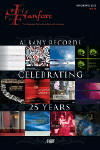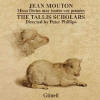Texte paru dans: / Appeared in:

Fanfare Magazine: 36:4 (03-04/2013)
Pour
s'abonner / Subscription information
Les abonnés à Fanfare Magazine ont accès aux archives du
magazine sur internet.
Subscribers to Fanfare Magazine have access to the archives of the magazine
on the net.
Gimell
CDGIM047

0755138104723
(ID262)
Consultez toutes les évaluations recensées pour ce cd
~~~~ Reach all the evaluations located for this CD
This album brings to two the number of available recordings of Mouton’s Missa Dictes moy toutes voz pensées, and supplies us with still more motets. I can’t write that we are inundated with recorded music by this great contemporary of Josquin, but it is heartening to find he’s finally getting some of the attention he deserves. The Missa Dictes was selected, according to Peter Phillips, because of his affection for gimells, twinned voice parts. (If you need an image for a reminder, think gimmal rings, those two or three hooped ones that can be fitted together to form one ring; the word is related.) The work’s Agnus Dei II goes further: It’s for three basses, treated as separate lines, and as startling as anything you’ll hear texturally from the Franco-Flemish School. But there’s much else to enjoy in the Mass, perhaps most spectacularly, an “Amen” to the Gloria in harmonically adventurous chords (based on a similar, more conventionally treated series of chords concluding the first half) that recalls another contemporary of Mouton’s, Pierre de la Rue.
A couple of the other pieces included on this album also use chordal contrasts to predominantly linear textures for effect. Quis dabit oculis, a ceremonial motet upon the death of Mouton’s then-patron, Queen Anne of Brittany, achieves a heartrending effect with chords on the repeated phrases, “moerore consumeris” (waste away in sorrow), and “deficit Anna” (Anna is gone). The extensive setting of Ave Maria…virgo serena also employs contrasting canonic linearity with slow chords, this time memorably identical, whenever the Virgin is invoked by name and honorific: “O Maria dulcissima,” “O Maria piissima,” and “O Maria sanctissima.” The composer’s setting of the shorter Ave Maria…benedicta tu instead plays between the voices with canonic variations in time, regular and irregular phrasing, and a mutable inner part that twines around first the upper line, and then the lower one—creating an impression of serenely smiling spontaneity that is a tribute to the technical challenges Mouton regularly set himself, and the inspired solutions he found. Much the same can be said of the canonic Salve nos, Domine, while the famous Nesciens mater is a quadruple canon at the upper fifth. The feat of accomplishment lies not in the structure—well, it does; but it is of a part with Mouton’s ability to find a music that delights for its ever-shifting beauty.
The Mass and
(almost inevitably, given its popularity) Nesciens mater are duplicated on
Quilisma 402, a disc of Mouton’s choral music featuring Graham Walker and
The Gentlemen of St John’s. Their performances are uniformly more spacious
and relaxed in tempo, but Phillips’s energy, attention to transparency, and
careful handling of dynamics makes, to my mind, a richer, more expressive
experience. The sound on this disc, recorded at the Chapel of Merton
College, Oxford, is just reverberant enough to define the room, without
weakening the divisions between the parts, or softening the fine enunciation
of the Tallis Scholars. Recommended. Well, considering the above, it goes
without saying, doesn’t it?
Fermer la fenêtre/Close window
Cliquez l'un ou l'autre
bouton pour découvrir bien d'autres critiques de CD
Click either button for many other reviews


